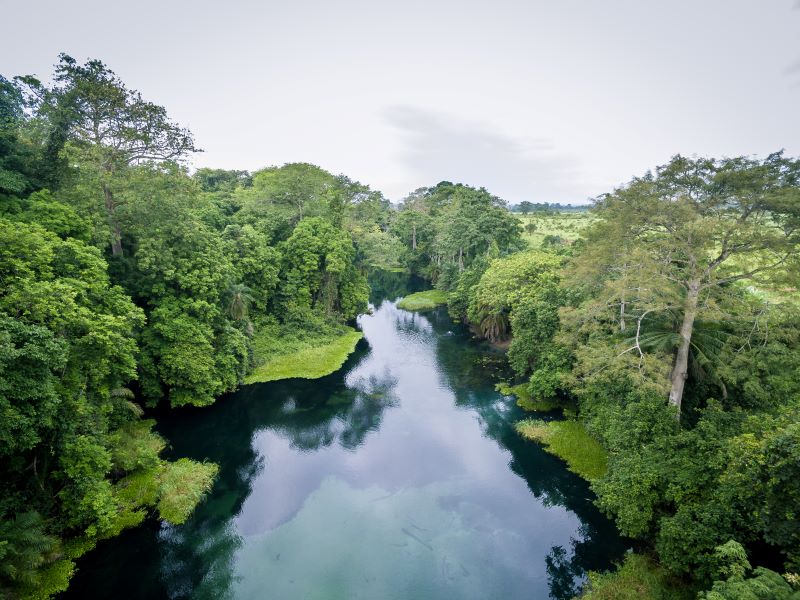Read the executive summary below or download the full report (PDF).
Executive Summary
Protecting tropical forests is good for the global climate and good for development in forested countries. In the absence of robust carbon markets, performance-based funding to reduce emissions from deforestation is a key way donors can provide the incentives and commitment tropical countries need to curtail forest loss.
Tropical forests are undervalued assets in the race to avert catastrophic climate change. They deliver a global—and very public— benefit by capturing and storing atmospheric carbon.
At the same time, they reduce drought and flooding, protect watersheds from erosion and support sustainable livelihoods for people living in and around them. They also make communities more resilient to climate change by protecting the people most vulnerable to extreme weather and climate related natural disasters.
Preventing tropical deforestation must be a key element of any global climate strategy.
Most important for climate mitigation: according to the International Panel on Climate Change, forests could provide as much as one third of the effective climate change mitigation we need to stay on the two degree pathway over the next couple of decades. Preventing tropical deforestation must therefore be a key element of any global climate strategy, particularly in the near term (2016–2020), for global temperature rise to stay below 2 degrees Celsius.
But forests in tropical developing countries are especially vulnerable to commercial pressures in a thoroughly global commodity market, and are disappearing: forest cover loss was about 8 million hectares per year (about the size of Maine) between 2001 and 2012, and is growing at a rate of 200,000 hectares per year.
There is, with good reason, widespread political and popular support in developed and developing countries for reducing and even eliminating deforestation as quickly as possible in forest-rich developing countries. In many forest-rich developing countries, the institutions and policies to do so have been or are being put in place, through development assistance projects and programs focused on regulatory, and fiscal reforms, support for land titling and enforcement of legal restrictions on forest use and for improvements in forest governance. More recently, some developed countries have modified international trade policies to prohibit the import of illegally produced timber and some global corporations have put in place procurement standards for sustainable production of soy, palm oil, timber, and beef.
But development assistance support for forest conservation has been piecemeal, small, and largely project based—far from sufficient to complement the steps tropical developing countries and global corporations are taking. Deforestation is a global crisis. Large-scale funding—comparable to the billions of dollars disbursed by the IMF and the World Bank to developing countries during the 2008–10 global financial crisis for example—to encourage and compensate tropical forest countries for slowing deforestation has barely begun to flow.
In the absence of adequate funding, tropical deforestation continues to rise in most areas of the tropics. One exception is Brazil, where deforestation in the Amazon basin was cut by 80 percent from its peak even while Brazil increased soy and cattle production. For other tropical forests to achieve Brazil’s success, serious financial incentives must be offered. While reduced deforestation will generally be in countries’ medium and long term self-interest, the short term financial and political costs are real and significant. Leaders of developing countries—who have plenty of other challenges to deal with—need a compelling value proposition if reduced deforestation is to become a priority.
This report argues that what is urgently needed is a tested but far from fully exploited approach to funding forest conservation: pay-for-performance transfers, under which public (and private) funders pay governments of forest countries annually as a function of their verified performance in reducing deforestation-based emissions of greenhouse gases. A fully developed normative and technical framework (called REDD+, for Reducing Emissions from Deforestation and Forest Degradation) was agreed between developed and developing countries (as part of the broader international climate negotiations process) in Warsaw in 2013.
The framework for pay-for-performance REDD+ finance exists and is being implemented now in several countries, in particular with funding from Norway and Germany. What is needed now is new, large (in billions of dollars) offers of financial support from advanced economies in the form of pay-for-performance, that is, linked to actual performance in producing verified emissions reductions.
Many tropical forest countries in the developing world are now ready, institutionally and politically, to respond to pay-for-performance REDD+ programs and are signaling in their commitments for the Paris climate summit their interest in going beyond their own commitments conditional on new international support. They have said so in signing the Lima Challenge, a joint ministerial announcement in December 2014 in which 14 countries challenged developed countries to join them in achieving deeper emission reductions through international collaboration. Increased funding commitments from rich countries would give a quick boost to existing efforts and set the stage for a long-term and cost-effective strategy to protect the forests and the global climate for us all. Getting new funding commitments from a few developed countries in place by the time of the Paris climate summit, preferably directly, through a global pool or through commitments to existing funds such as the Forest Carbon Partnership Facility (FCPF) Carbon Fund, would be a good first step.
Working Group recommendations
This report provides ideas for how to mobilize additional funding for new pay-for-performance agreements supporting forest conservation. Based on the research, findings, and discussions of the Center for Global Development Working Group on Scaling Up Performance-based Transfers for Reduced Tropical Deforestation, it presents the Working Group’s simple and practical solutions to the technical, bureaucratic, financial, and political challenges that have limited public, private, and philanthropic pay-for-performance funding. The report suggests positive steps to overcome these challenges.
The main recommendation of the Working Group is that developed countries need to provide certainty to tropical forest countries that their actions to reduce deforestation will be rewarded by performance payments from the international community.
-
Recommendation #1. Official funders in advanced economies should offer (in Paris and post-Paris agreements) to pay tropical forest countries to reduce one billion tons a year of carbon emissions from deforestation over the next five years, through pay-for-performance transfers. Payments would be tied to measured and verified reductions in greenhouse gas emissions associated with maintaining forests (following REDD+ conventions and protocols). Major emitters in the rich world, including the United States, United Kingdom, Germany, France, Australia, and Japan would ideally negotiate pay-for-performance contracts with one or more forested countries in the developing world.
Alternatively, they could join existing partnerships such as the Amazon Fund in Brazil or agreements between Norway and Germany with Ecuador and Colombia. In the short term, joining these bilateral/trilateral agreements may be preferable because these are already in place and have been partially “liberated” from conventional aid practices so are more easily able to channel funding. Or they could commit payments to one of the performance-based multilateral funds (the FCPF Carbon Fund, forthcoming performance-based mechanisms in the BioCarbon Fund Initiative for Sustainable Forest Landscapes, once these are available, or a potential results-based window for forests in the Green Climate Fund). Ideally these multilateral programs would also be streamlined to minimize obstacles that result from grafting conventional aid practices onto pay-for-performance programs.
Though the goal would be tons of reduced carbon emissions, for ease of tracking each pledge could be expressed in dollars. Each partnership agreement between developed economies, forest nations and possible private investors would negotiate the appropriate price of carbon. If major emitters, perhaps including new donors like China, committed to fund a billion tons of emission reductions from tropical forests a year and if the negotiated price were $5–10 per ton of carbon, the total cost could be $5–10 billion a year—a small fraction of the annual $135 billion in official development assistance. If a number of countries adopted regulatory measures that created compliance regimes to reduce carbon, a market reference price could emerge to guide pricing, and the price might increase.
-
Recommendation #2. To complement public funding, influential actors in the private sector—buyers of forest commodities, sovereign wealth funds, corporate environmental, social and governance funds, philanthropies and impact investors—should align their purchasing and investing decisions with REDD+ objectives, building on initiatives to eliminate imports of illegally logged timber and sustainable production of key commodities. They should become advocates for REDD+ policies and programs with both rich and forest rich country governments. Those companies that wanted to buy verified emission reductions could commit to pay-for-performance funding to reduce deforestation. For this to serve its purpose, they would need to move beyond projects to support large-scale pay-for-performance schemes at the national or state/province level. The most effective and efficient solution would probably be for them to piggyback on the various channels described above.
-
Recommendation #3. Tropical forest countries should be encouraged to specify the amount of international financial support they would need to enable them to undertake additional emission reductions from reduced deforestation. They could propose a structure for international partnership deals tailored to national conditions and priorities as Brazil and Guyana have done in their agreements with Norway. In the pledges they provide for Paris and after, developing tropical forest countries should be encouraged to indicate how much they would be willing to do on their own and how much more they could do with international financial support, as Indonesia, Mexico, Ethiopia, and Morocco have already done.
How could this be done? The report addresses potential concerns about channeling large-scale funding through performance-based transfers. It draws on the early experience of a small but increasing number of pay-for-performance agreements to reduce deforestation launched in recent years, as well as results-based payment programs in other sectors. And it proposes new financing mechanisms.
-
Trust but verify: avoid “aid-ification” of programs by entering into simple contracts that pay for verified performance. Funders and forest countries can enter into performance agreements simpler than those currently being discussed. It’s important to put the forest country in the driver’s seat in designing the program. Contracts should provide certainty that performance will be rewarded. Funders ought to trust forest countries to deliver results and then provide funding when the agreed result is verified. The funder and recipient would agree on the baseline, the measure of improvement, and the method to verify results, and then enter into a contract and provide payments once the result is accomplished. If there are no results, there is no payment. Substantial donor support has already been provided to forest countries over many years to prepare them for performance payment schemes, support that has been gratefully received and that has had a positive impact in terms of REDD+ readiness, including having capacity to handle MRV (measurement, reporting and verification) and safeguards against environmental and social risks. Now is the time to build on that support and try something new: large scale pay-for-performance commitments. Developing countries are already feeling the impacts of climate change, underlining the urgency to act quickly.
-
Avoid imposing conditions on how results are achieved. Funders ought to avoid requiring plans, detailed information on program design or other evidence of “readiness.” If countries request funding for up-front investments and actions, funders can help to ensure that an integrated financing plan is in place and help secure funding, including advances against performance contracts. But evidence of up-front funding or a fully funded program need not be a condition for entering into the performance agreement.
-
View performance payments as part of a multifaceted program to achieve results, not as “double funding” of actions. Countries will need to use many sources of financing to achieve results, including their own budgets. As programs are increasingly undertaken at the national and jurisdictional scale, multiple partners will support multiple activities. When reduced emissions are fully measured and reported, it will not be possible to directly attribute these to any single investment or to specific actions. Rather, each funding source will have made a contribution alongside many others, including forest countries’ own efforts.
-
Avoid “double-demanding”: requiring that a country deliver a result and then imposing conditions on how the performance payments are used. The recipient country ought to propose how the payment is used, whether for general budget support to finance sustainable national development plans, for low carbon or “green growth” investments, or for forest-specific results. For example, Brazil proposed that performance payments be channeled through the Amazon Fund to deepen results in reducing deforestation and Guyana funds its low carbon development strategy.
-
Accept volatility of disbursements. Performance-based programs do entail potential non-performance and thus possible non-disbursement. Official development assistance flows themselves are highly volatile. While inconvenient from a bureaucratic budget flow perspective, non-disbursement would appeal to legislators who worry about ineffective use of tax revenues, since funds don’t flow without results. Despite potential hiccups in disbursements, funders ought to commit to making performance payments available to countries or jurisdictions that are ready to generate emission reductions at scale. And there are ways to smooth disbursements: channel funds through multilateral funds like the FCPF Carbon Fund or use a “committed payment” facility, described in the report.
-
Negotiate conservative baselines to ensure “additionality” of actions. Funders and forest countries should negotiate mutually agreeable baselines (reference levels) to avoid the risk of overpayment for results or payment for actions that might have taken place without the performance agreement. Reference levels should differ depending on whether a forest nation has already converted substantial areas of forest to other uses or has low levels of deforestation.
-
Rely on advanced satellite monitoring to measure, report on, and verify results. New satellite monitoring technologies provide reliable, high-quality data not just on changes in forest cover; they increasingly allow monitoring even of species composition, carbon density, and conservation of natural forest.
-
Encourage performance agreements at a large scale— The United Nations Framework Convention on Climate Change (UNFCCC) has decided that programs should be national or at the level of sub-national administrative jurisdictions. This avoids the risk of “leakage” (where reducing emissions in one place shifts them to another). To address concerns about the lack of “permanence” (when emissions avoided today might still occur in the future), the term of the performance agreement should be multi-year with potential to extend, to keep funding flowing for the long term.
-
Manage concerns about potential misuse of funds, damage to the environment, and harm to forest communities. Draw on the experiences of ongoing programs, the substantial work done in UNFCCC negotiations, and considerable investment in readiness and capacity building. Satellite data can increasingly be used to ensure compliance with environmental safeguards (including preserving biodiversity and natural forests). Where possible, positive social and environmental outcomes could be assured by relying on the forest country’s own institutions and frameworks and verifying appropriate progress annually. Performance agreements provide forest governments with an incentive to keep forests standing and to use funds efficiently. The UNFCCC negotiations framework provides strong guidance about respect for the rights of indigenous peoples.
To protect the rights and livelihoods of indigenous peoples and local communities (so-called “social safeguards”), performance agreements can go beyond a “do no harm” standard to include benefits-sharing formulas for indigenous peoples and local communities, as the Brazil–Norway and Guyana–Norway programs do. For both environmental and social safeguards, performance agreements can require transparent annual reporting and a review process to assess evidence that environment conditions and the rights of indigenous peoples and other local communities are being safeguarded. The UNFCCC has finalized guidance for annual reporting on environmental and social safeguards, in keeping with national circumstances.1 Funders can hold off transferring money to forest nations that don’t provide such information or are not open to annual review. The information provided by forest countries can be audited by reputable third parties.
-
Recognize governance challenges but use performance payments to create incentives to take difficult public policy actions. Forests are under-represented in global action to reduce greenhouse gas emissions for climate mitigation in part because of legitimate concerns that important tropical forest countries may lack capacity and have poor institutions or weak enforcement. The creation of an internationally visible program to reduce deforestation as an incentive mechanism to improve governance has not been tried on a large scale. Performance payments can create incentives to overcome governance challenges and can encourage forest countries to implement the policy changes and public policy actions that will reduce deforestation.
-
Generate new funding for performance-based transfers to reduce deforestation . Support efforts to include international forest offsets in compliance carbon market programs. California has legislation allowing REDD+ international forest offsets and is in the process of finalizing implementing rules and regulations. The promising progress made by California and other subnational government programs ought to be encouraged and supported. The International Civil Aviation Organization is considering implementing a mandatory global carbon offset scheme which could provide significant opportunities; they should be encouraged to include international forest offsets in their scheme. In the Green Climate Fund, the development of a specific mitigation mechanism to pay-for-performance in reducing deforestation ought to be encouraged. Ideally, new schemes to generate new sources of funding would be established. These include, for instance, a committed payment facility to reduce deforestation or an endowment-like Forest Foundation Fund, both described in this report.
Other than a few pioneers, the world has not gotten nearly serious enough about providing financial incentives to tropical forest countries to reduce current trends in deforestation. This approach could fulfill forests’ potential to slow climate change while delivering development benefits. The time to do so is now. Pay-for-performance partnerships to preserve forests should be a key part of the action agenda in Paris and beyond, for the benefit of forest communities and our global climate.
Download the full report here.
Rights & Permissions
You may use and disseminate CGD’s publications under these conditions.





